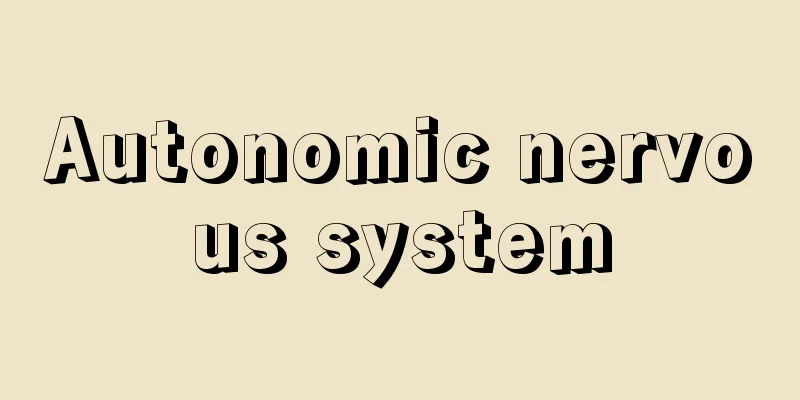Autonomic nervous system

|
Among the peripheral nerves that originate from the brain and spinal cord and reach every corner of the body, the autonomic nervous system is a collective term for the nerves related to the functions of various organs that are directly related to maintaining life, such as breathing, circulation, and digestion, i.e., vegetative functions. The activity of the autonomic nervous system is regulated solely by reflexes, completely unrelated to will, and regulates the functions of various organs day and night. The autonomic nervous system consists of two systems: the sympathetic nervous system and the parasympathetic nervous system. In humans, the sympathetic nervous system originates from the thoracic and lumbar parts of the spinal cord (thoracic and lumbar spinal cord), while the parasympathetic nervous system consists of the vagus nerve that originates from the cranial nerve nuclei of the midbrain, pons, and medulla oblongata, and the pelvic nerve that originates from the lowest part of the spinal cord, i.e., the sacral spinal cord. The superior centers for these autonomic peripheral pathways are the medulla oblongata and hypothalamus, where the integration of the sympathetic and parasympathetic nervous systems takes place. Furthermore, the autonomic nervous system is closely related to the cerebral cortex, especially the limbic lobe, and is strongly influenced by it. [Hidenobu Mashima] Interaction between the two nervous systemsThe ends of the autonomic nerves are distributed mainly to the smooth muscles of the heart, other internal organs and blood vessels, and various exocrine and endocrine glands, and regulate the degree of their activity. In many cases, the sympathetic and parasympathetic nerves send nerve fibers to one organ independently (called dual control). Moreover, the actions of these two nervous systems are opposite to each other, and when one promotes the activity of an organ, the other acts to suppress it. In other words, the sympathetic and parasympathetic nervous systems exert antagonistic effects on each other (called antagonistic control. However, blood vessels are an exception, and most blood vessels only receive sympathetic nerves). Furthermore, when the activity of the sympathetic nerves to a certain organ is increased, the activity of the parasympathetic nerves is suppressed, and conversely, when the parasympathetic nerves are active, the activity of the sympathetic nerves is suppressed (this is called reciprocal control). In addition, both nervous systems, especially the sympathetic nerves, are always in a state of excitement to a certain extent, and continue to send stimuli (impulses) to the organs they control. This is called sustained innervation. Therefore, the excitability of an organ is maintained when the stimulating effects of both nervous systems are in perfect balance. [Hidenobu Mashima] Sympathetic nervous system actionThe action of the sympathetic nervous system is enhanced when we are mentally excited or exercising. This can be understood relatively easily by considering the various physical changes we experience when we try to escape from a frightening situation. In such a situation, the sympathetic nervous system becomes excited, causing the eyes to open wide (dilated pupils), the face to turn pale (constriction of the facial blood vessels), and psychological sweating to increase, resulting in the so-called "sweating palms." In addition, the smooth muscles of the bronchi relax, causing the bronchi to expand and promoting breathing. Furthermore, cardiac activity is promoted, contracting more strongly, and the heart rate increases, making the patient feel a throbbing in the chest (the so-called "chest pounding" state). The above are examples of when the action of the sympathetic nervous system is enhanced, but at this time, the peristalsis of the digestive tract, the secretion of digestive juices, and the activity of the urogenital system, which are not directly related to strenuous physical exercise, are suppressed. Furthermore, when an animal is mentally excited, the arrector pili muscles contract and the hair stands on end. This can be said to be a state of readiness for fight or flight created by the activity of the sympathetic nervous system. The sympathetic nervous system also stimulates the adrenal medulla, promoting the secretion of a hormone called adrenaline. Adrenaline has effects on various organs that are very similar to those of the sympathetic nervous system, and amplifies the effects of sympathetic nervous excitement. [Hidenobu Mashima] Parasympathetic nervous system actionThe parasympathetic nervous system generally becomes more active when we are at rest and relaxed, that is, when we are resting or sleeping. As a result, the pupils narrow, the bronchial smooth muscles contract, the heart beat is suppressed, and the cardiac output decreases, the heart rate decreases, and blood pressure drops. In addition, peristalsis of the digestive tract, secretion of digestive juices, and activity of the urogenital system are promoted. In this way, it can be said that the parasympathetic nervous system works to create conditions suitable for the recovery of the exhausted body through its activity. However, as already mentioned, even in such a state, the sympathetic nervous system continues to be active, sending stimuli to various organs. [Hidenobu Mashima] Differences in chemical messengersWhen an electrical signal, an excitation, travels through a nerve fiber and reaches its terminal, a chemical substance is released from it. This substance is called a chemical transmitter, and acts on the cells of an organ to change its function. As mentioned before, the actions of the sympathetic and parasympathetic nerves are completely different because the chemical transmitters are different between them. The chemical transmitter released from the sympathetic nerve fiber terminal is noradrenaline, and the chemical transmitter released from the parasympathetic nerve fiber terminal is acetylcholine. These chemical transmitters are released from the nerve fiber terminal and act on each organ, and then are quickly broken down by the action of enzymes in the blood. The effect of sympathetic and parasympathetic excitation on various organs is determined by the amount of chemical transmitters released from each terminal. Therefore, it is possible to obtain the same effect by directly acting on these chemical transmitters on the organs without stimulating the nerves. For example, when norepinephrine is injected intravenously, it can produce changes similar to those seen when sympathetic nerves are stimulated, such as an increase in heart rate due to stimulation of cardiac activity, an increase in blood pressure due to arterial constriction, and dilation of the pupils. [Hidenobu Mashima] animalLike humans, the autonomic nervous systems of vertebrates have two systems, each of which has an antagonistic effect. Here, we will go into more detail about the connection between nerve fibers (called fibers in medicine). In the autonomic nervous system, myelinated nerve fibers (preganglionic fibers) emerging from nerve cells in the central nervous system are relayed to another neuron (neuron) in a ganglion or nerve plexus before reaching the organ they control. The fibers of this neuron are generally unmyelinated and are called postganglionic fibers. Postganglionic fibers of the sympathetic nervous system are generally adrenergic, except for those that control sweat glands. In contrast, postganglionic fibers of the parasympathetic nervous system and preganglionic fibers of the sympathetic and parasympathetic nervous systems are cholinergic. The basic properties of the autonomic nervous system described above have been investigated mainly in mammals, including humans, such as cats and dogs. The prototype of the developed autonomic nervous system of mammals can be seen in the nerve network that regulates the function of the internal organs of hemichordates and protochordates, which are thought to be close to the ancestors of vertebrates, especially the pharynx, intestines, and their appendages. Nerve networks are also found in the digestive systems of flatworms and circumferential animals, and it is thought that the nervous system that controls the function of internal organs is widely present in triploid animals (all animals above flatworms), but little research has been done on this topic. In the protochordate amphioxus, fibers equivalent to preganglionic fibers that emerge from the center reach the peripheral nerve network directly. There is no sympathetic trunk, and neither the skin nor the vascular system are innervated by the center. In cyclostomes, the parasympathetic nerve is limited to the vagus nerve. The blood vessels of sharks are innervated by the center, and neurons are replaced in ganglia close to the center. The development of the autonomic nervous system of fish varies greatly depending on the group, and it is said that the basic system of the autonomic nervous system was established in vertebrates above amphibians. [Akira Murakami] [References] | | | | |©Shogakukan "> Autonomic Nervous System (Sympathetic and Parasympathetic) Source: Shogakukan Encyclopedia Nipponica About Encyclopedia Nipponica Information | Legend |
|
脳や脊髄(せきずい)から発して身体の隅々にまで達する末梢(まっしょう)神経のうち、呼吸、循環、消化のような生命の維持に直接関係する諸臓器の機能、すなわち植物性機能に関係する神経を総称していう。自律神経の活動は意志とはまったく無関係に、もっぱら反射によって調節され、昼夜を分かたず諸臓器の機能を調整している。自律神経系は交感神経系および副交感神経系の2系統からなる。ヒトの場合、交感神経は脊髄の胸および腰の部分(胸髄・腰髄)から発し、副交感神経は中脳・橋(きょう)・延髄の脳神経核から発する迷走神経と、脊髄の最下部、すなわち仙髄から発する骨盤神経からなる。これらの自律神経末梢路に対する上位中枢は延髄および視床下部であり、ここで交感・副交感両神経系の統合が行われている。さらに自律神経系は大脳皮質、とくに辺縁葉とも密接な関係にあり、その影響を強く受けている。 [真島英信] 両神経系の相互作用自律神経の末端は主として心臓、その他の内臓・血管などの平滑筋、各種の外分泌腺(がいぶんぴつせん)・内分泌腺に分布し、それらの活動の程度を調節している。交感神経および副交感神経は、多くの場合、一つの器官にそれぞれが独立して神経線維を送っている(二重支配という)。しかもこの二つの神経系の作用は互いに反対であり、ある器官に対して一方がその活動を促進する場合は、他方は逆に抑制するように働く。つまり交感・副交感両神経系は相互に拮抗(きっこう)的な作用を及ぼしている(拮抗支配という。ただし、血管の場合は例外で、多くの血管には交感神経しかきていない)。さらに、ある器官に対する交感神経の活動が亢進(こうしん)しているときには副交感神経の活動は抑制され、逆に副交感神経が活発に活動しているときには交感神経の活動は抑制される(これを相反支配という)。また、両神経系とくに交感神経は、つねにある程度の興奮状態を持続しており、支配する器官に対して刺激(インパルス)を送り続けている。これを持続神経支配という。したがって両神経系の及ぼす刺激効果がちょうどつり合ったところに、その器官の興奮性が維持されているといえる。 [真島英信] 交感神経の作用交感神経の作用は精神的に興奮したときや運動時に亢進する。このことは、われわれが恐ろしい場面から逃げ出そうとするときなどに経験するさまざまな身体的変化を考えてみれば比較的容易に理解することができる。このような場面にあっては、交感神経が興奮することによって、目は見開かれ(瞳孔(どうこう)散大)、顔面は蒼白(そうはく)となり(顔面の血管の収縮)、さらに精神性発汗が盛んになり、いわゆる「手に汗を握る」状態となる。また、気管支平滑筋が弛緩(しかん)するため、気管支は拡張し、呼吸は促進される。さらに心臓の活動(心活動)も促進されて収縮が強くなり、かつ心拍数が増加して胸の鼓動を感じるようになる(いわゆる胸がどきどきする状態)。以上が交感神経の作用が亢進したときの例であるが、このとき、激しい身体の運動には直接関係しない消化管の蠕動(ぜんどう)運動や消化液の分泌、および泌尿生殖器系の活動は逆に抑制される。なお、動物が精神的に興奮したときには立毛筋が収縮して体毛が逆立つ現象がみられる。これは、闘争または逃避のための準備状態が交感神経の活動によってつくられたといえる。また、交感神経は副腎(ふくじん)髄質を刺激してアドレナリンというホルモンの分泌を促進させる。アドレナリンは交感神経の作用とよく似た効果を諸臓器に引き起こし、交感神経興奮の効果を増幅させる働きをもっている。 [真島英信] 副交感神経の作用副交感神経は、一般にわれわれが安静にし、ゆったりとくつろいでいるとき、すなわち休息中や睡眠時にその活動が亢進する。その結果として瞳孔の縮小、気管支平滑筋の収縮が生じるほか、心臓の拍動が抑制されて1回心拍出量の減少、心拍数の減少、血圧の低下がおこる。また、消化管の蠕動運動や消化液の分泌、泌尿生殖器系の活動は促進される。このようにみると、副交感神経はその活動によって消耗した身体の回復に適した条件を整える働きをもっているといえる。ただし、すでに述べたように、このような状態においても交感神経系は絶えず活動を続けており、諸臓器に刺激を送っている。 [真島英信] 化学伝達物質の違い電気的信号である興奮が神経線維を伝わってその末端に到達すると、そこから化学物質が放出される。この物質は化学伝達物質とよばれ、臓器の細胞に作用してその機能を変化させるものである。交感神経と副交感神経の作用が前に述べたようにまったく異なっているのは、この化学伝達物質が両者間で異なっているからにほかならない。交感神経線維末端から放出される化学伝達物質はノルアドレナリンであり、副交感神経線維末端から放出されるのはアセチルコリンである。これらの化学伝達物質は神経線維末端から放出され、各臓器に作用を及ぼしたのち、血液中の酵素の働きによって速やかに分解される。諸臓器に対する交感・副交感神経興奮の影響は、それぞれの末端から放出される化学伝達物質の多寡によって決まってくる。したがって、神経を刺激しなくても、直接、臓器にこれらの化学伝達物質を作用させることによって同様の効果を得ることが可能となる。たとえばノルアドレナリンを静脈内に注射すると、心活動の促進による心拍数増加、動脈収縮による血圧の上昇、瞳孔の散大など、交感神経が興奮したときと同様の変化を生じさせることができる。 [真島英信] 動物脊椎(せきつい)動物の自律神経系にもヒトと同様に2系統があり、それぞれが拮抗的に作用することは同じであるが、ここでは、神経繊維(医学では線維と表記する)の連絡様式についてさらに詳しく述べる。 自律神経系においては、中枢神経系内の神経細胞から出た有髄の神経繊維(節前繊維)は、その支配する器官に達する前に、神経節または神経集網においてもう一つのニューロン(神経単位)に中継される。このニューロンの繊維は一般に無髄で、節後繊維とよばれる。交感神経の節後繊維は、汗腺を支配するものを除き、一般にアドレナリン作動性である。これに対し、副交感神経系の節後繊維、および交感・副交感神経系の節前繊維はコリン作動性である。以上のような自律神経系の基本的な性質は、ネコやイヌなどヒトを含む哺乳(ほにゅう)類を中心として調べられたものである。 哺乳類の発達した自律神経系は、脊椎動物の祖先に近いと考えられる半索動物や原索動物の内臓、とくに咽頭(いんとう)や腸とその付属器官の働きを調整している神経集網にその原型をみることができる。扁形(へんけい)動物や円形動物などの消化系にも神経集網があり、内臓の機能を制御する神経系は広く三胚葉(はいよう)性動物(扁形動物以上のすべての動物)に存在するものと考えられるが、研究はほとんど行われていない。原索動物のナメクジウオでは、中枢から出た節前繊維に相当する繊維は、直接、末梢の神経集網に達している。交感神経幹はなく、皮膚、血管系ともに中枢からの神経支配を受けていない。円口類では副交感神経は迷走神経に限られている。サメ類の血管は、中枢からの神経支配を受けており、中枢に近い神経節でニューロンの交代が行われる。魚類の自律神経系の発達は、グループによる変異が大きく、自律神経系の基本的な系が確立したのは、両生類以上の脊椎動物であるとされている。 [村上 彰] [参照項目] | | | | |©Shogakukan"> 自律神経系(交感神経系と副交感神経系) 出典 小学館 日本大百科全書(ニッポニカ)日本大百科全書(ニッポニカ)について 情報 | 凡例 |
<<: Autonomic nervous system disorder
>>: Autogenic training - Jiritsukunren (English spelling)
Recommend
Stephens, AS
…A cheap, popular novel that was popular in the U...
Ship calculation method - Senpakusanpo
Although several identical ships may be built, eac...
Main dormitory - Tonomori
A ritsuryo government office belonging to the Impe...
Democracy - minshushugi (English spelling) democracy
The English word "democracy" originally...
Krill - Okiami (English spelling) krill
A general term for the order Euphausiacea of th...
Guangdong Marshal's Office Headquarters - Guangdong Marshal's Office Headquarters
...The party was rejuvenated by welcoming dynamic...
Goclenius, R. (English spelling) GocleniusR
…The term goes back to the Latin ontologia, or ph...
Kogosho Conference - Kogoshokaigi
An Imperial Conference was held on December 9, 18...
Weather by month / year - Uonzu
A composite graph showing monthly changes in preci...
maturation
…Growth corresponds to the English word growth, a...
Western Region Buddhism
This refers to Buddhism that was popular in the we...
Storytelling - Wageki
A Chinese theater genre. It refers to a spoken-wo...
Imao
The central area of the northeastern part of Ka...
Aochiei
...Dutch scholar and doctor of the Edo period. So...
Uda Mountains - Udasanchi
This mountain range occupies Uda County in the ce...




![Kawaminami [town] - Kawaminami](/upload/images/67cb46f0ae7a8.webp)




